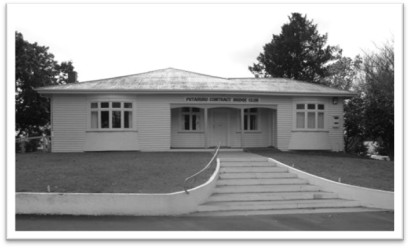HH-40: WDFF Building, Putāruru

Date of Photograph: 04/09/2008
Location and Zoning Information | |
Address |
Overdale Street adjacent to the monument and across from the Library. |
Current Owner |
SWDC |
Legal Description |
Lot 5 DPS 4338 |
Zoning |
Commercial Zone |
Valuation Number |
0541735600 |
Google Maps Link |
|
Architecture | |
Date of Construction |
1930s |
Materials |
The building is located on a slight rise and has a sweeping entry. The covered porch and double doors suit the building’s use as a hall. The façade is slightly asymmetrical, but appears balanced. It has the low restrained stile of a bungalow-cottage with its boxed eaves and porch tucked into the building. The WDFF building probably dates from the 1930’s based on the architecture. The building has good architectural integrity. The external and internal architectural elements have been retained, i.e. original double doors, central entry, bow windows on the front façade, casement window, interior paneling, fireplace and a large meeting room. |
Architecture/Engineer/Builder |
|
Condition |
The building has been altered through additions on the sides and rear of the building. Additional research would be useful and provide information about when the building was altered. In general the alterations have been restrained and have not affected the street façade. The building has retained substantial architectural integrity. |
Original Site Recommendation |
|
Current Use |
The current use, as a contract bridge club rooms, is in keeping with the building’s original purpose and use, i.e. for meetings, functions, and WDFF business. |
Statement of Significance | |
Criteria for Scheduling: 1, 3, 6, 10, and 12 1. Aspect of history - associated with the agriculture industry in SWDC. 3. Community association – politics and social life in Putāruru. 6. Educational Use – could be included as an item on a heritage trail. 10. Architectural - example of the bungalow cottage style (circa 1930s). 12. Integrity –good condition/ additions do not compromise the street frontage of the structure. District Plan RulesDemolition - NC. Protection focus - 1, 3, 6, 10, and 12. Mitigate the effects of demolition by requiring the applicant to provide a Historical Building Documentation (HBD) should include the structure’s history, photographic documentation, and measurements of the item prior to removal. Alterations necessary for the primary purpose of improving structural performance, fire safety or physical access – CON -Refer to HH-R2. Other Additions/Alterations – DIS, refer to Rule HH-R3. Protection focus – 10. Effects can be mitigated/ remedied through: a) HBD (see mitigating the effects of demolition). b) Design Rules: The overall visual character/ shape of the original building should be identifiable. The addition should not dominate the existing building frontage on Overdale Street. The sweeping lawn and stairway should be retained (the lawn and stairway supports the architectural impact of the building). New work should be restricted to the rear of the building and not be evident from the street/ road frontage. Special elements that are associated with the rarity or architectural uniqueness or craftsmanship of the structure should be retained:
c) Building Materials Rule: If repair of the building is proposed the materials used for the exterior walls and elements (i.e. windows and doors) should be similar in type, dimensions and profile as the existing exterior fabric of the building. Repair of the Structure – PER. Refer to HH-R1. Protection focus – 10. a) Building Materials Rule: If repair of the buildings is proposed the materials used for the exterior walls and elements (i.e. windows, building base, and central entry surround) should be similar in type, dimensions and profile as the existing exterior fabric of the building. b) Design Rule: Repair or replication work should match the existing design, profile, and materials (i.e. Wood) of the building elements. Reuse/Change of Use – PER. Refer to HH-R1. Protection focus – 1. This is generally allowed and supported. Rationale for supporting reuse- history is an ongoing process. Reuse of historic structures in most instances ensures the structure is retained for future generations. (The building is already being reused as a Contract Bridge Club). Advice or Community concerns will be considered as well as economic viability, Occupational Safety and Health, zoning, etc. Disturbance of the site surface / earthworks – PER. Protection focus – 7. Existing plan rule relating to archaeological sites. This only applies if evidence is found to indicate that there was a pre-1900 site in the development zone. Internal Changes –PER. Refer to HH-R1. Protection focus – 10. Design Rule: Significant interior spaces and use areas should be identifiable (such as the large meeting room with fireplace). Historic internal elements should be retained (such as fireplace, panelled walls and ceilings, doors and architraves, period hardware, etc). Remodelling of rooms, hallways, and facilities (kitchens, etc) is allowed but alterations must be documented (HBD). Relocation – DIS, refer to Rule HH-R3. Protection focus – 1 and 3. Relocation may be necessary to preserve an item for future generations. Mitigate the effects by 1) Consulting with the local community and/ or consulting with Iwi or special interest groups, 2) Relocating to a similar setting, 3) Documenting (HBD), 4) Applying rules relating to archaeological sites. | |